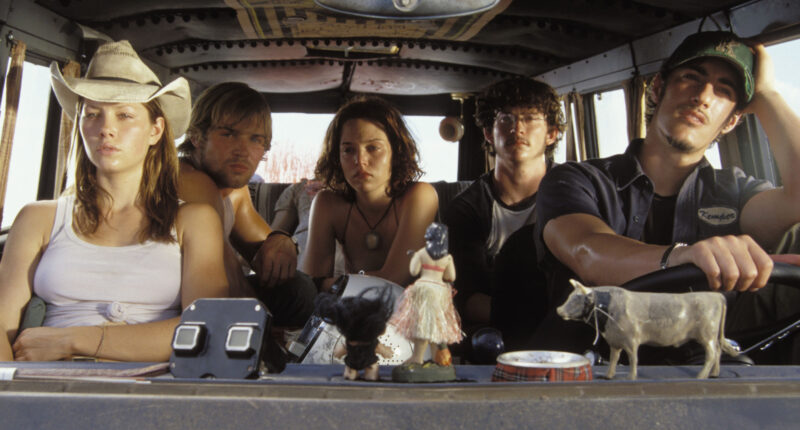Share this @internewscast.com
The introduction of Leatherface in “The Texas Chainsaw Massacre” marked the beginning of one of horror’s most enduring villains. Released in 1974, the film faced numerous challenges before hitting the big screen, including finding a distributor and making edits to adjust its rating due to the intense violence depicted. Many audiences believed the film was based on true events, adding to the controversy. Yet, director Tobe Hooper’s determination paid off, as his low-budget slasher flick grew into one of the genre’s most successful franchises.
The original film follows a group of teenagers as they desperately try to escape Leatherface, a man notorious for wearing masks made of human skin and wielding a chainsaw to dispatch his victims. His gruesome acts are a family affair, with his relatives aiding in luring unsuspecting victims to their home where they partake in the carnage. As the series expanded, it delved deeper into Leatherface’s backstory, chronicling his horrific deeds and the relentless efforts of those seeking to bring his family to justice.
With a total of nine films in the “Texas Chainsaw Massacre” series, knowing the best sequence to watch them can be daunting. Fortunately, you can follow the straightforward release order to experience the saga as it unfolded:
“The Texas Chain Saw Massacre” (1974)
-
“The Texas Chainsaw Massacre 2” (1986)
-
“Leatherface: The Texas Chainsaw Massacre III” (1990)
-
“Leatherface: The Texas Chainsaw Massacre III” (1990)
-
“The Return of the Texas Chainsaw Massacre” (1995)
-
“The Texas Chainsaw Massacre” (2003)
-
“The Texas Chainsaw Massacre: The Beginning” (2006)
-
“Texas Chainsaw 3D” (2013)
-
“Leatherface” (2017)
-
“Texas Chainsaw Massacre” (2022)
Why is that the correct order to watch The Texas Chainsaw Massacre movies?
After the first four “Texas Chainsaw Massacre” films, several different storylines popped up as the rights to the franchise changed and different production companies gave the IP their own flair. There’s been a remake, differing prequels, and plot shifts, only some of which link back to the original 1974 project. This can make deciding on a way to watch the franchise confusing, since there isn’t a great way to sort the entries in a chronological order that would make sense.
Since there is no ideal way to arrange the entries with the four different timelines at play, it is best to watch the movies in release order, allowing audiences to see the changes in the story over time. Like other slashers of the 1970s, many teams have worked on the franchise, and watching the films in release order lets you see how each one has built on the previous, seeing the creative choices they’ve made, and deciding which timeline resonates with you the most. It might not be ideal, but it is the best way to see how “The Texas Chainsaw Massacre” has grown over time.
The Texas Chain Saw Massacre (1974)
“The Texas Chainsaw Massacre” is the original film that built a franchise all about a man, his chainsaw, and the things he does with it for his family. The movie follows five teens in a van traveling around when they pick up an odd hitchhiker. While they’re able to get away from him, when they need gas, their trip goes awry again as they move away from their vehicle and check out a seemingly abandoned house.
The 1974 entry not only started the franchise, but it established the key elements of it, like the dinner table sequence, and had a lasting impact on the slasher genre, particularly when it comes to the weapons horror antagonists use. It’s the initial introduction to Leatherface, and while it doesn’t give audiences everything they need to know about the killer, it gives enough to understand the family dynamic and their end goals.
That said, you have to start with this one because it’s the first, creating the character people now think of when they see a chainsaw. “The Texas Chainsaw Massacre” is also widely credited as developing the final girl trope in slashers, and it was added to the National Film Registry of the Library of Congress in 2024, marking its importance in movie history. All of that combined makes it mandatory as the first watch.
The Texas Chainsaw Massacre 2 (1986)
“The Texas Chainsaw Massacre 2” continues the story started with the first film, taking place 13 years later. Franklin’s uncle, Lefty (Dennis Hopper), is trying to figure out what happened to his nephew, following a trail of chainsaw killings across the state in an attempt to track down the killer. As a former Texas Ranger, he’s in a unique position compared to most, and while helping investigate a recent death by chainsaw, he uncovers the Sawyer family and their current whereabouts, which is now an abandoned amusement park.
It’s only right to watch the second movie next, especially since you won’t understand whose death Lefty is trying to avenge otherwise. While a significant amount of time has passed since Sally made it out of Leatherface’s clutches, it’s clear that someone getting away hasn’t deterred the Sawyer family. Sure, they’re operating out of a new location, one that is creepier than the house, but they’ve spent the last decade continuing their “work,” even if they haven’t learned from their past mistakes. Chainsaw killings are still being reported, so they aren’t exactly hiding. The film also shows how integrated the family is in the community, with one member even winning a chili cook-off, making you question how much you truly know your neighbor, which adds to the horror.
Leatherface: The Texas Chainsaw Massacre III (1990)
“Leatherface: The Texas Chainsaw Massacre III” sets a new tone for the franchise, showing a shift in the Sawyer family patterns, even if it results in similar endings to the first two films. Michelle (Kate Hodge) and Ryan (William Butler) keep running into issues on their trip through Texas, from a strange interaction and possible murder at a gas station to consistent car troubles. Leatherface comes after them, clearly trying to use their car trouble to his advantage and lure them toward the family home. The couple and others are chased in and around the house, history repeating itself, but it’s still a welcome change in the franchise.
“The Texas Chainsaw Massacre III” has several parallels to the 1974 movie, and it chronologically takes place after the 1986 entry, so it’s best to watch this one third. Similar imagery, like getting away in the truck with Leatherface revving the chainsaw in the background, Grandpa at the table, and the use of the meat hooks in the house, feels like a return to form.
However, there are new inclusions, like a gilded, engraved chainsaw, showing how the operation is continuing to change. It’s a bit more of an active, hunting Leatherface than audiences are familiar with, though he’s still getting help luring in victims. This time it’s from Tex, played by Viggo Mortensen, whom the couple first sees at the gas station.
The Return of the Texas Chainsaw Massacre (1995)
“The Return of the Texas Chainsaw Massacre,” also known as “Texas Chainsaw Massacre: The Next Generation,” takes audiences to prom night as four teens try to escape the Sawyer family. What comes next is expected in a “Texas Chainsaw Massacre” film: car issues, this time resulting in a crash with another vehicle; finding an old house; and several chases with Leatherface and his family.
This fourth installment is where the story takes a bit of a turn. There is the iconic table scene, but there’s also the introduction that the family works for a secret society to kill people, which inherently changes the entire nature of their crimes. Up to this point, it’s been established that this is something this family does as cannibals, so the addition of a secret society is a bit odd. The person seemingly associated with the society doesn’t like how they are carrying out their tasks, eventually rescuing the final girl, with an apology that doesn’t actually feel like one because he clarifies that she was supposed to have a different experience.
If you were to watch this film on its own, you probably wouldn’t notice these additions. However, when watched in release order, it simply feels like an attempt to up the ante of the franchise, or maybe even that it’s trying to expand on the lore in an interesting way.
The Texas Chainsaw Massacre (2003)
The 2003 movie is a remake of the 1974 classic. While it tells much of the same story, it uses different events to do so. There are still teens driving through Texas in their van and picking up a hitchhiker, but this time, the hitchhiker dies by suicide in front of them, rather than just injuring themselves with a stolen knife like the original film. They stop at a gas station as they try to work through what they’ve just witnessed, and head into the brush behind it, coming across a house.
“The Texas Chainsaw Massacre” modernizes the narrative at points, like in hot-wiring cars to make an escape, while leaning into something the franchise hadn’t up to this point: incompetent law enforcement. It’s played up as the family is able to get away with their crimes because the local sheriff is always inebriated, rather than being sneaky or flying under the radar. There’s also the addition of a family member who doesn’t agree with their actions, presenting a more complicated dynamic than the previous movies, since the entire family was in on it up to this entry. However, all of this only stands out as changes if you watch the films in release order.
The Texas Chainsaw Massacre: The Beginning (2006)
“The Texas Chainsaw Massacre: The Beginning” takes audiences back in time, before the story of teens in a van picking up a strange hitchhiker. We learn how Thomas, the original Leatherface we met in the 2003 film, was born in a slaughterhouse and then, as an adult, worked for that same slaughterhouse. He took it hard when it closed, killing the supervisor and taking a chainsaw with him, which started what would become a decades-long killing spree.
“The Beginning” shows the start of Thomas’s life and when he began his new occupation. Watching it after the 2003 remake provides a fun viewing experience, since certain events that take place in the 2006 entry recontextualize parts of the previous one, making it clear how the family has operated as long as they have when the teens come across them. It shows just how deep they have their (meat) hooks into the community, and why no one is able to stop them, even law enforcement. It’s terrifying to see, and includes a repeat of the most iconic scene of the original 1974 movie, which notably wasn’t in the remake. Though it is easily one of the worst films of the franchise, it’s still a fun watch.
Texas Chainsaw 3D (2013)
Like many other horror franchises, “Texas Chainsaw Massacre” got a 3D film in the 2010s. Meant as a sequel to the 1974 movie, ignoring the projects that came before it, the 2013 installment shows people finally going after the Sawyer family. A group of vigilantes burns down their home in the 1970s, killing everyone but a baby, who is taken in by another family. Fast forward to the 2010s, and an adopted teen named Heather (Alexandra Daddario) gets a letter about an inheritance, and decides to take a group of friends with her to go to a house she’s never been to. Unsurprisingly, things don’t go well.
“Texas Chainsaw 3D” does what others in the franchise haven’t up to this point: we get more than just chases around the Sawyer home. While the movie initially follows the formula we’ve come to expect, it includes other sequences common in horror films of the time, like Heather looking through files at a police station. A bit of humanity is infused into this entry, as Heather learns who her biological relatives are and decides to do right by them. It’s a new ending for “Texas Chainsaw Massacre,” changing things up in a way that, while it didn’t strike a chord with critics or audiences, was a nice attempt to take the franchise in a new direction that can only be appreciated when viewed in release order.
Leatherface (2017)
“Leatherface” is another prequel film, but it tells a different story of the titular character. After helping his family kill the sheriff’s daughter, Jedidiah (Sam Strike) is sent to the Gorman House Youth Reformery. With a time jump to a decade later, a nurse bonds with Jedidiah, now called Jackson. His family is trying to see him, and when his mother shows up, chaos ensues, resulting in deaths and several patients of the facility breaking out, including Jackson.
While we learn in “The Texas Chainsaw Massacre: The Beginning” that Leatherface worked at a slaughterhouse and how that impacted him, “Leatherface” shows more of the childhood of the horror antagonist, and presents a new way for how he got his chainsaw. It looks at Leatherface in a different way than the 2006 film, showing family encouragement as a key reason for his shift from boy to killer, rather than something rooted in losing a part of his life.
“Leatherface” is meant to be a prequel to “Texas Chainsaw 3D,” so it makes sense to view them in this order, especially to see everything the Sawyer family has been through. Both show a lead female character sympathizing with Leatherface, even though it isn’t in their best interest. It sets a different tone for the franchise, trying to give it a bit more depth than the initial movies.
Texas Chainsaw Massacre (2022)
“Texas Chainsaw Massacre” is the 2020s direct sequel to the original film. The movie follows a group of young adults intending to gentrify the area 50 years after the killings of the 1970s, which doesn’t go over well when it’s discovered someone was illegally evicted from one of the properties. Leatherface appears when they try to check out an orphanage, and Sally from the first installment shows up, seemingly determined to kill him. However, nothing goes to plan for anyone, resulting in vehicle chases, self-driving car rescues, and Sally encouraging one of the potential victims to just succumb to their fate.
The 2022 entry certainly tries to modernize the franchise, incorporating gentrification as a major theme, alongside plenty of disturbing moments that the franchise is known for. Watching this film last is best, since it builds on the 1974 project, and gives you the necessary context for Sally’s previous encounter with Leatherface. The return of Sally is an intriguing twist, even if it isn’t utilized as well as it is in other horror sequels, like 2025’s “I Know What You Did Last Summer.” Her choices might come across as strange to audiences, but, after eight other entries, it seems to be a creative choice rooted in Sally’s mental health and meant to give the final girl a different storyline than her peers.
Is there another way to watch The Texas Chainsaw Massacre movies?
While we’ve recommended watching “The Texas Chainsaw Massacre” movies in release order due to the constant shifting of the production rights, there are four different timelines within the franchise. You can watch the first four entries, those released in 1974, 1986, 1990, and 1995, to see the original one. These are all in chronological order already, letting you see the first film and the sequels building off of it. You can then stop right there, completing the original “Texas Chainsaw Massacre” continuity.
If you want to watch the 2000s timeline, also known as the Platinum Dunes timeline because of the production company behind them, chronologically, you can watch “The Texas Chainsaw Massacre: The Beginning” and then the 2003 remake. That will let you see how that iteration of Leatherface became a chainsaw-wielding killer, and then some of his crimes. You can also watch the 2010s timeline from Millennium Films by first viewing “Leatherface” as the prequel, then the original 1974 project, ending with “Texas Chainsaw 3D.”
Finally, if you like the return of the original Leatherface final girl, you can watch the 2020s timeline from Legendary Entertainment by watching the 1974 movie and then the 2022 one. By watching these four iterations, you can follow the four separate continuities of the franchise in their respective chronological orders, picking and choosing which one you like best.








